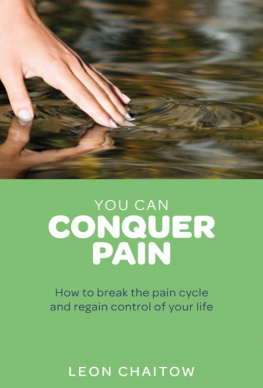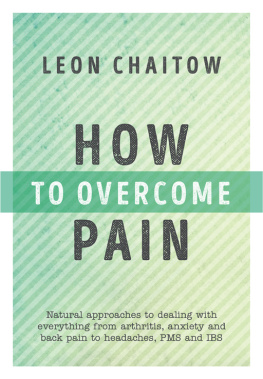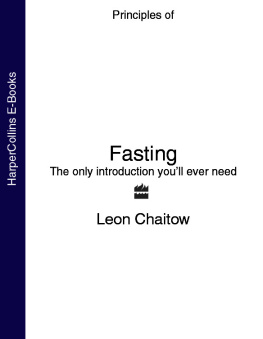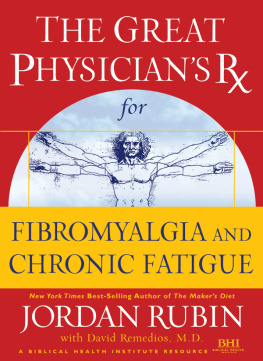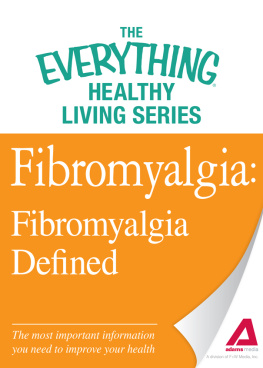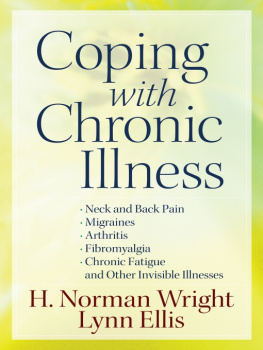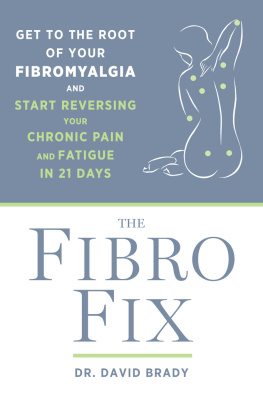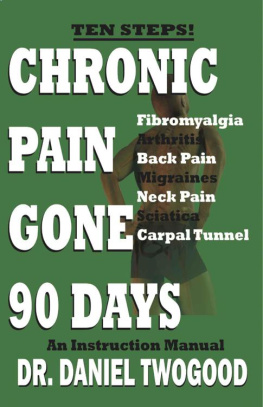While the author of this work has made every effort to ensure that the information contained in this book is as accurate and up to date as possible at the time of publication, medical and pharmaceutical knowledge is constantly changing and the application of it to particular circumstances depends on many factors. Therefore it is recommended that readers always consult a qualified medical specialist for individual advice. This book should not be used as an alternative to seeking specialist medical advice, which should be sought before any action is taken. The author and publishers cannot be held responsible for any errors and omissions that may be found in the text, or any actions that may be taken by a reader as a result of any reliance on the information contained in the text, which is taken entirely at the reader's own risk.

This edition first published in 2015 by Conari Press
an imprint of Red Wheel/Weiser, LLC
With offices at:
665 Third Street, Suite 400
San Francisco, CA 94107
www.redwheelweiser.com
Sign up for our newsletter and special offers by going to
www.redwheelweiser.com/newsletter.
Copyright 1995, 1998, 2001 by Leon Chaitow
All rights reserved. No part of this publication may be reproduced or transmitted in any form or by any means, electronic or mechanical, including photocopying, recording, or by any information storage and retrieval system, without permission in writing from Red Wheel/Weiser, LLC. Reviewers may quote brief passages. Originally published in 2001 by Thorsons, an imprint of HarperCollinsPublishers, ISBN: 0-00-711502-4.
ISBN: 978-1-57324-656-9
Library of Congress Cataloging-in-Publication Data available upon request
Cover design by Jim Warner
Text design by Valerie Cooper
Typeset in Chaparral Pro & Univers
Printed in the United States of America
EBM
10 9 8 7 6 5 4 3 2 1
www.redwheelweiser.com
www.redwheelweiser.com/newsletter
Contents
Questionnaire Index
Foreword
It is difficult to approach a new book by Dr. Leon Chaitow without some measure of bias. The exceptional merit of his previous books leaves one expecting the same from each new one. This biased expectation is fully justified by this new edition of Fibromyalgia and Muscle Pain. With the clarity that is a hallmark of Chaitow's books, he makes these complex disorders easy to understand. At the same time, he provides the reader with an array of practical, selfhelp methods of treatment. Chaitow also leaves the reader with the invaluable awareness that any self-help method works best as part of an integrated approach to treatment. This integrated approach is vital to most patients' recovery from fibromyalgia and muscle pain, and having long championed the approach, Chaitow teaches it as few other writers can. This third edition of Fibromyalgia and Muscle Pain is essential not only for those who want to free themselves from these disorders, but also for loved ones and clinicians who want to help them do so.
Dr. John C. Lowe
Board Certified: American Academy of Pain Management
Director of Research: Fibromyalgia Research Foundation
Introduction: The Big Picture
Fibromyalgia and other chronic muscle pain and fatigue syndromes are complex. Before investigating what is known about the causes and the possible solutions to these problems, an explanation is needed as to how the body becomes unwell, and how it can be helped to recover.
To do this, some simple examples will be used and the reader is asked to refer to the first few pages of ). This deals with the biochemical, biomechanical and psychological load with which your body, and mind, are coping, and what happens when the load is too heavy, our adaptive processes fail and symptoms start.
Let's start with a few basic examples.
If you cut yourself, unless the wound is infected the cut will heal over a period of a few days. You know this, and you trust your body to do the repair work necessary. All you have to do is avoid getting the wound dirty and try not to aggravate it, as repair takes place automatically.
More simplistically still, if you play a sport or dig the garden before you have acclimatized your muscles to the efforts involved, you will be stiff and will ache for a day or so afterwards. You know that this will pass as normal repair mechanisms sort out the overload and minor muscle damage.
If you catch a cold, and you are in reasonable health, you know that the cold will get better, in a week or two. There are many things you can do to make yourself more comfortable during the recovery phase, but not much you can do to speed up the process. But you do know that you will get better, and that the healing process is automatic.
In the same way, if you eat contaminated food, you may develop diarrhoea or vomit. Neither symptom is pleasant, but both are designed to get whatever is undesirable out of your system as fast as possible. Usually, with a little rest and a lot of liquid, recovery is rapid and complete. The body will heal itself.
In fact, most illnesses get better on their own (research suggests well over 90 per cent of infections get better without any treatment), but few of the symptoms associated with getting well are enjoyable (fever, diarrhoea, inflammation, etc.).
But headaches do go away, cuts do heal, bones do mend, and colds and most infections are taken care of by our amazing defence and repair systems. There is a constant tendency towards wellness, but the processes involved are not always comfortable.
Together, the self-repair, self-regulating and self-balancing systems of the body are known as the homeostatic mechanisms. Homeostasis also takes care of other demands. When you go out into the cold, and start to shiver, your homeostatic mechanisms are trying to warm you up. This is called adaptation: you are adapting to the cold.
When a cut is healing, the area will be red and inflamed. Inflammation is a sign that the homeostatic repair process is going on. This process of inflammation is necessary for recovery and tissue repair. Inflammation is a sign that your defence systems are adapting to, and repairing, the injury.
When you have an infection, your temperature goes up. This is a sign that the immune system is fighting (adapting to) the infection. The symptom is not pleasant (few symptoms are), but for recovery to take place it is essential that the bacteria or virus is overwhelmed by the homeostatic defences of the body. An elevated temperature is a sign that your defence systems are adapting to the infection.
But when your homeostatic mechanisms have to adapt to a great many things at the same time, they may not always be able to cope. Adaptation systems may begin to break down (see ). For example, someone may not be getting enough essential vitamins and/or minerals in the diet, and/or not getting adequate exercise, and/or has picked up a viral infection which never seems to quite go away, and/or is not sleeping well, and/or is under work and/or emotional stress, and/or has a slight hormonal imbalance. Each of these problems (stresses) may be relatively minor, and could probably be sorted out by taking appropriate actions such as eating more sensibly, exercising more, ensuring a better sleep pattern, doing something positive about the stress, getting advice and treatment for the hormonal and the viral problems, etc.
But if nothing is done, and these various adaptive demands (and others) continue, the body's defence and repair systems can become so overloaded that they begin to break down. And as this happens, more chronic symptoms start to appear.
Next page

